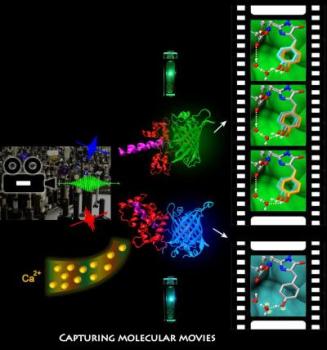Jul 2 2014
Researchers today announced the creation of an imaging technology more powerful than anything that has existed before, and is fast enough to observe life processes as they actually happen at the molecular level.
 Fluorescent protein biosensors provide a technology to capture the biochemical process of life almost like a motion picture that could be viewed a frame at a time. This may allow the targeted design of next-generation biosensors to track life processes and battle diseases. Credit: Graphic courtesy of Oregon State University
Fluorescent protein biosensors provide a technology to capture the biochemical process of life almost like a motion picture that could be viewed a frame at a time. This may allow the targeted design of next-generation biosensors to track life processes and battle diseases. Credit: Graphic courtesy of Oregon State University
Chemical and biological actions can now be measured as they are occurring or, in old-fashioned movie parlance, one frame at a time. This will allow creation of improved biosensors to study everything from nerve impulses to cancer metastasis as it occurs.
The measurements, created by the use of short pulse lasers and bioluminescent proteins, are made in femtoseconds, which is one millionth of one billionth of a second. A femtosecond, compared to one second, is about the same as one second compared to 32 million years.
That's a pretty fast shutter speed, and it should change the way biological research and physical chemistry are being done, scientists say.
Findings on the new technology were published today in Proceedings of the National Academy of Sciences, by researchers from Oregon State University and the University of Alberta.
"With this technology we're going to be able to slow down the observation of living processes and understand the exact sequences of biochemical reactions," said Chong Fang, an assistant professor of chemistry in the OSU College of Science, and lead author on the research.
"We believe this is the first time ever that you can really see chemistry in action inside a biosensor," he said. "This is a much more powerful tool to study, understand and tune biological processes."
The system uses advanced pulse laser technology that is, in itself, fairly new, and builds upon the use of "green fluorescent proteins" that are extremely popular in bioimaging and biomedicine. These remarkable proteins glow when light is shined upon them. Their discovery in 1962, and the applications that followed were the basis for a Nobel Prize in 2008.
Existing biosensor systems, however, are created largely by random chance or trial and error. By comparison, the speed of the new approach will allow scientists to "see" what is happening at the molecular level and create whatever kind of sensor they want by rational design. This will improve the study of everything from cell metabolism to nerve impulses, how a flu virus infects a person, or how a malignant tumor spreads.
"For decades, to create the sensors we have now, people have been largely shooting in the dark," Fang said. "This is a fundamental breakthrough in how to create biosensors for medical research from the bottom up. It's like daylight has finally come."
The technology, for instance, can follow the proton transfer associated with the movement of calcium ions – one of the most basic aspects of almost all living systems, and also one of the fastest. This movement of protons is integral to everything from respiration to cell metabolism and even plant photosynthesis. Scientists will now be able to identify what is going on, one step at a time, and then use that knowledge to create customized biosensors for improved imaging of life processes.
"If you think of this in photographic terms," Fang said, "we now have a camera fast enough to capture the molecular dance of life. We're making molecular movies. And with this, we're going to be able to create sensors that answer some important, new questions in biophysics, biochemistry, materials science and biomedical problems."